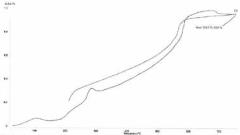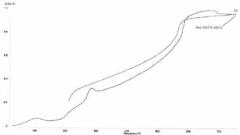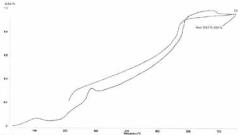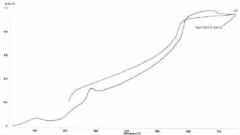Ivoclar Vivadent IPS PressVEST Speed User Manual [en, de, fr, it, es, ru, pl]

IPS®
PressVEST Speed
Instructions for Use |
Käyttöohjeet |
Page 2 |
Sivu 34 |
Gebrauchsinformation |
Bruksanvisning |
Seite 6 |
Side 38 |
Mode d’emploi |
Gebruiksaanwijzing |
Page 10 |
Pagina 42 |
Istruzioni d’uso |
Oδηγίες Xρήσεως |
Pagina 14 |
Σελίδα 46 |
Instrucciones de uso |
Kullanma Talimatı |
Pagina 18 |
Sayfa 50 |
Instruções de uso |
àÌÒÚ Û͈Ëfl |
Página 22 |
ëÚ . 54 |
Bruksanvisning |
Instrukcja stosowania |
Sidan 26 |
Strona 58 |
Brugsanvisning |
|
Side 30 |
|
For dental use only.
Rx only
Manufacturer:
Ivoclar Vivadent AG, 9494 Schaan/Liechtenstein
www.ivoclarvivadent.com
1

Indication
The phosphate-bonded IPS PressVEST Speed investment material (Type 1, Class 2) can be used with the following press ceramics in the Ivoclar Vivadent press furnaces.
–IPS e.max® Press
–IPS e.max® ZirPress
–IPS Empress® Cosmo
–IPS InLine® PoM (Press-on Metal-Ceramics)
Contraindication
All other applications not listed in the indications.
Delivery form
–IPS PressVEST Speed Powder 25 bags, 100 g each, including 1 measuring cup
–IPS PressVEST Speed Liquid, 0.5 litre
–IPS PressVEST Speed Powder 50 bags, 100 g each, including 1 measuring cup
–IPS PressVEST Speed Liquid, 1.0 litre
Storage
–Storage at 12–28 °C / 54–82 °F
–Store powder in a dry place
–The liquid must not be exposed to temperatures below +5 °C / 41 °F (frost susceptible!) If the liquid should freeze, it will be unusable (crystallization).
Processing temperatures
–Room temperature 18 °C – max. 23 °C / 64 °F – max. 73 °F.
–Any other processing temperature decisively affects the setting behaviour.
–A higher processing temperature accelerates the chemical process.
–A lower processing temperature delays the chemical process.
Investment ring system and press plunger
–For IPS e.max and IPS InLine PoM ingots, it is imperative to use the IPS Investment Ring System (100 g, 200 g and 300 g).
–For IPS e.max and IPS InLine PoM ingots, it is imperative to use the IPS Alox plunger.
–For IPS Empress Cosmo ingots, it is imperative to use the IPS Empress Investment Ring System (100 g, 200 g).
–For the IPS Empress Cosmo ingots, the IPS Empress Alox plunger or the IPS One-Way-Plunger can be used.
–Use the IPS Silicone Ring for investment. IPS Silicone Ring is used both for the IPS Investment Ring System and the IPS Empress Investment Ring System.
Mixing ratio
IPS e.max® Press
Indication |
Concentration |
100-g investment |
200-g investment |
300-g investment |
|
ring |
ring |
ring |
|||
approx. |
|||||
|
Liquid : dist. water |
Liquid : dist. water |
Liquid : dist. water |
||
|
|
||||
(Thin) veneers, partial crowns, |
60% |
16 ml : 11 ml |
32 ml : 22 ml |
--- |
|
single crowns |
|||||
|
|
|
|
||
Hybrid abutments, hybrid |
75% |
20 ml : 7 ml |
40 ml : 14 ml |
--- |
|
abutment crowns |
|||||
|
|
|
|
||
Inlays |
50% |
14 ml : 13 ml |
27 ml : 27 ml |
--- |
|
3-unit bridges in the anterior |
50% |
--- |
27 ml : 27 ml |
--- |
|
and premolar region |
|||||
|
|
|
|
||
Pressing over electroplated |
60% |
16 ml : 11 ml |
32 ml : 22 ml |
--- |
|
frameworks |
|||||
|
|
|
|
2

IPS e.max® ZirPress
Indication |
|
Concentration |
100-g investment |
200-g investment |
300-g investment |
|
|
ring |
ring |
ring |
|||
|
approx. |
|||||
|
|
Liquid : dist. water |
Liquid : dist. water |
Liquid : dist. water |
||
|
|
|
||||
Pressing over ZrO2 |
single |
60% |
16 ml : 11 ml |
32 ml : 22 ml |
48 ml : 33 ml |
|
tooth constructions |
||||||
|
|
|
|
|||
Pressing over ZrO2 |
frameworks |
50%-60% |
--- |
27 ml : 27 ml |
48 ml : 33 ml |
|
bridge constructions |
||||||
|
|
|
|
|||
IPS Empress® Cosmo
Indication |
|
Concentration |
100-g investment |
200-g investment |
300-g investment |
|
|
ring |
ring |
ring |
|||
|
approx. |
|||||
|
|
Liquid : dist. water |
Liquid : dist. water |
Liquid : dist. water |
||
|
|
|
||||
Preprosthetic buildup in |
40%-50% |
11 ml : 16 ml |
22 ml : 32 ml |
--- |
||
combination |
with CosmoPost |
13.5 ml : 13.5 ml |
27 ml : 27 ml |
|||
|
|
|||||
IPS InLine® Pom – Press-on-metal ceramic
Indication |
Concentration |
100-g investment |
200-g investment |
300-g investment |
|
ring |
ring |
ring |
|||
approx. |
|||||
|
Liquid : dist. water |
Liquid : dist. water |
Liquid : dist. water |
||
|
|
||||
Pressing over opaquerized |
60% |
16 ml : 11 ml |
32 ml : 22 ml |
48 ml : 33 ml |
|
metal frameworks |
|||||
|
|
|
|
The total quantity of liquid (liquid + dist. water) must not be altered. The indications regarding the liquid concentration are approximates and may be adjusted, if required. Do not dilute the liquid to below 40%.
Processing
Excess of separating agents may cause reactions with the investment material and affect the press result. Disperse excess with compressed air before investment.
–Fill liquid into the mixing cup.
–Add powder.
–Thoroughly mix the investment material with a spatula for 20 seconds until even wetting of the powder is achieved.
Vacuum mixer
Vacuum mixing time (at room temperature) |
2.5 min |
|
|
Speed |
approx. 350 rpm |
|
|
Processing time |
6 – 7 min |
Setting time |
min. 30 min – max. 45 min |
The processing time depends on the material temperature, mixing quantity, mixing time and mixing intensity. A higher material temperature and/or longer mixing time shortens the processing time.
Investment
–Mix max. 400 g of investment material in one go
–Closely observe the mixing ratio!
–Investment is carried out on a shaker under slight vibration. Allow the investment ring to set without manipulating it.
Some aspects influencing the setting expansion of the investment material
–Temperature of the investment material and the liquid
–Residual water in the mixing cup, atmospheric humidity
3
English

Preheating / holding times
Starting temperature |
850 °C / 1562 °F |
|
(Switch on the preheating furnace in time) |
||
|
||
Holding time after reaching |
100-g investment ring – min. 45 min |
|
|
||
200-g investment ring – min. 60 min |
||
the final temperature of 850 °C / 1562 °F |
||
|
||
300-g investment ring – min. 90 min |
||
|
||
|
|
If more than 2 investment rings are preheated at the same time, the holding time at the final temperature has to be prolonged by 15 minutes per additional investment ring.
Note
If several Speed investments are to be conducted, they should be invested consecutively and placed into the preheating furnace at an interval of approx. 20 minutes.
When placing the investment rings in the preheating furnace, make sure that the furnace temperature does not drop substantially. The stipulated holding time counts from the point when the preheating temperature has been reached again.
Preheating of ingots and Alox plungers
|
IPS e.max® Press / IPS e.max® ZirPress / IPS InLine® PoM |
|
Ingot |
|
No preheating |
|
|
|
Alox plunger |
|
No preheating |
|
|
|
|
IPS Empress® Cosmo |
|
Ingot |
|
No preheating |
|
|
|
Alox plunger |
|
Preheating |
|
|
|
Important information
–Do not use a debubblizer (tenside). Reactions with the investment material may occur.
–Consistent results can only be achieved under consistent conditions and if the Instructions for Use are observed.
–Dilute the liquid exclusively with distilled or de-ionized water.
–Liquid concentration: The more distilled or de-ionized water is added to the mixing liquid, the lower the setting expansion. Additionally, the strength of the investment material is reduced. Do not dilute the liquid to below 40%.
–Use only dry, clean instruments to process the investment material. Do not use plaster mixing cups.
–Carefully cut open the powder bags and remove the entire contents of the bags.
–Do not invest under pressure, since this changes the product properties.
–The setting time must be closely observed, since it decisively influences the expansion.
To ensure thorough heating of the investment rings in the preheating furnace, the following points have to be observed:
–Load the preheating furnace to maximally half of the available utility space.
–Always place the investment rings in the rear part of the preheating furnace.
–Place the investment rings as quickly as possible in the preheating furnace. Make sure that the furnace temperature does not drop substantially.
–Always remove pressed investment rings from the press furnace immediately after the end of the program and place them on a grid for cooling.
–Always place the investment rings in the preheating furnace with the opening facing down.
–If more than two 200-g investment rings have to be preheated in the preheating furnace, we recommend investing them consecutively and placing them in the preheating furnace at an interval of approximately 20 minutes.
–Do not place the investment rings in direct contact with each other. Allow air circulation.
4

Safety notes
–Do not open the furnace during the first 20 minutes of preheating: Burn hazard caused by wax fumes that might ignite in the air!
–This material contains quartz, which may cause lung diseases (silicosis or cancer) when inhaled. Prevent the inhalation of dust and wear a suitable dust mask.
Physical data |
|
|
|
(according to ISO 15912:2006) |
|
|
|
– |
Flow characteristics: |
116 mm |
Liquid concentration 50% |
– |
Initial set: |
11 minutes |
Liquid concentration 50% |
– |
Compressive strength: |
6 MPa |
Liquid concentration 50% |
– |
Linear thermal expansion: |
0.9 % |
Liquid concentration 50% |
|
|
|
|
|
|
|
|
This material has been developed solely for use in dentistry. Processing should be carried out strictly according to the Instructions for Use. Liability cannot be accepted for damages resulting from failure to observe the Instructions or the stipulated area of application. The user is responsible for testing the products for their suitability and use for any purpose not explicitly stated in the Instructions. Descriptions and data constitute no warranty of attributes and are not binding.
5

Indikation
Die phosphatgebundene IPS PressVEST Speed Einbettmasse (Typ 1, Klasse 2) kann für folgende Presskeramiken zur Pressung in den Ivoclar Vivadent Pressöfen verwendet werden.
–IPS e.max® Press
–IPS e.max® ZirPress
–IPS Empress® Cosmo
–IPS InLine® PoM (Press-on Metal-Keramik)
Kontraindikation
Alle weiteren Anwendungen, die nicht als Indikation beschrieben sind.
Lieferform
–IPS PressVEST Speed Pulver 25 Beutel a 100 g incl. 1 Messbecher
–IPS PressVEST Speed Liquid 0.5 Liter
–IPS PressVEST Speed Pulver 50 Beutel a 100 g incl. 1 Messbecher
–IPS PressVEST Speed Liquid 1.0 Liter
Lagerung
–Lagerung bei 12–28 °C
–Pulver trocken lagern
–Liquid keiner Temperatur von weniger als +5°C aussetzen (frostempfindlich!) Sollte die Flüssigkeit einmal gefrieren, wird diese unbrauchbar (Kristallbildung).
Verarbeitungstemperatur
–Raumtemperatur 18 °C – max. 23°C.
–Eine abweichende Verarbeitungstemperatur beeinflusst das Abbindeverhalten entscheidend.
–Eine höhere Verarbeitungstemperatur beschleunigt den chemischen Prozess.
–Eine niedrigere Verarbeitungstemperatur verzögert den chemischen Prozess.
Muffelsystem und Press-Kolben
–Für IPS e.max und IPS InLine PoM Rohlinge ist zwingend das IPS Muffelsystem (100 g, 200 g und 300 g) zu verwenden.
–Für IPS e.max und IPS InLine PoM Rohlinge ist zwingend der IPS Alox-Kolben zu verwenden.
–Für IPS Empress Cosmo-Rohlinge ist zwingend das IPS Empress Muffelsystem (100 g, 200 g) zu verwenden.
–Für die IPS Empress Cosmo-Rohlinge wird der IPS Empress Alox Kolben oder der IPS Empress One-way- Plunger verwendet.
–Zum Einbetten ist der IPS Silicone Ring zu verwenden. Der IPS SIlicone Ring ist sowohl für das IPS Muffelsystem als auch für das IPS Empress Muffelsystem einsetzbar.
Anmischverhältnis
IPS e.max® Press
Indikation |
Konzentration |
100 g Muffel |
200 g Muffel |
300 g Muffel |
|
Liquid : dest. |
Liquid : dest. |
Liquid : dest. |
|||
ca. |
|||||
|
Wasser |
Wasser |
Wasser |
||
|
|
||||
(dünne) Veneers, Teilkronen, |
60% |
16 ml : 11 ml |
32 ml : 22 ml |
--- |
|
Einzelzahnkronen |
|||||
|
|
|
|
||
Hybrid-Abutment, Hybrid- |
75% |
20 ml : 7 ml |
40 ml : 14 ml |
--- |
|
Abutment-Krone |
|||||
|
|
|
|
||
Inlays |
50% |
14 ml : 13 ml |
27 ml : 27 ml |
--- |
|
3-gliedrige Brücken im Front- |
50% |
--- |
27 ml : 27 ml |
--- |
|
und Prämolarenbereich |
|||||
|
|
|
|
||
Überpressen von Galvano |
60% |
16 ml : 11 ml |
32 ml : 22 ml |
--- |
6

IPS e.max® ZirPress
Indikation |
Konzentration |
100 g Muffel |
200 g Muffel |
300 g Muffel |
|
Liquid : dest. |
Liquid : dest. |
Liquid : dest. |
|||
ca. |
|||||
|
Wasser |
Wasser |
Wasser |
||
|
|
||||
Überpressen von ZrO2- |
60% |
16 ml : 11 ml |
32 ml : 22 ml |
48 ml : 33 ml |
|
Einzelzahnkonstruktionen |
|||||
|
|
|
|
||
Überpressen von ZrO2- |
50%-60% |
--- |
27 ml : 27 ml |
48 ml : 33 ml |
|
Brückenkonstruktionen |
|||||
|
|
|
|
IPS Empress® Cosmo
Indikation |
Konzentration |
100 g Muffel |
200 g Muffel |
300 g Muffel |
|
Liquid : dest. |
Liquid : dest. |
Liquid : dest. |
|||
ca. |
|||||
|
Wasser |
Wasser |
Wasser |
||
|
|
||||
Präprothetischer Aufbau |
|
11 ml : 16 ml |
22 ml : 32 ml |
|
|
in Kombination mit dem |
40%-50% |
--- |
|||
13.5 ml : 13.5 ml |
27 ml : 27 ml |
||||
CosmoPost |
|
|
|||
|
|
|
|
||
|
|
|
|
|
IPS InLine® Pom – Press-on-metal ceramic
Indikation |
Konzentration |
100 g Muffel |
200 g Muffel |
300 g Muffel |
|
Liquid : dest. |
Liquid : dest. |
Liquid : dest. |
|||
ca. |
|||||
|
Wasser |
Wasser |
Wasser |
||
|
|
||||
Überpressen von |
60% |
16 ml : 11 ml |
32 ml : 22 ml |
48 ml : 33 ml |
|
opaquisierten Metallgerüsten |
|||||
|
|
|
|
Die Gesamtmenge Flüssigkeit (Liquid + dest. Wasser) muss in jedem Fall beibehalten werden. Die Angaben zur Liquidkonzentration sind Richtwerte und können gegebenenfalls korrigiert werden. Liquid nicht unter 40% verdünnen!
Verarbeitung
Überschüsse von Isoliermittel können Reaktionen mit der Einbettmasse hervorrufen und das Pressergebnis beeinträchtigen. Vor dem Einbetten sind Überschüsse mit Druckluft zu verblasen.
–Liquid in den Anmischbecher füllen
–Pulver einstreuen
–Einbettmasse mit dem Spatel 20 sec. gut durchmischen, bis eine gleichmässige Benetzung des Pulvers erreicht ist.
Vakuumrührdauer (bei Raumtemperatur) |
2,5 min |
|
|
Drehzahl |
ca. 350 U/min |
|
|
Verarbeitungszeit |
6 – 7 min |
Aushärtungszeit |
mind. 30 min – max. 45 min |
Die Verarbeitungszeit ist abhängig von der Materialtemperatur, der Mischmenge, der Rührdauer und der Mischintensität. Eine höhere Materialtemperatur bzw. längere Mischdauer verkürzt die Verarbeitungszeit.
Einbetten
–Maximal 400 g Einbettmasse auf einmal anmischen
–Mischungsverhältnis genau einhalten!
–Das Einbetten erfolgt auf einem Rüttler unter leichter Vibration. Die eingebettete Muffel erschütterungsfrei abbinden lassen und keine Manipulationen an der Muffel vornehmen.
Einige Punkte, die die Abbindeexpansion der Einbettmasse beeinflussen
–Temperatur der Einbettmasse und des Liquids
–Restwasser im Anmischbecher, Luftfeuchtigkeit
7
Deutsch

Vorwärmen / Haltezeiten
Aufsetztemperatur |
850 °C |
|
(Vorwärmofen rechtzeitig einschalten) |
||
|
||
Haltezeit ab Erreichen der Endtemperatur |
100 g Muffel – mind. 45 min |
|
|
||
200 g Muffel – mind. 60 min |
||
850°C |
||
|
||
300 g Muffel – mind. 90 min |
||
|
||
|
|
Werden mehr als 2 Muffeln gleichzeitig vorgewärmt, so ist die Haltezeit auf Endtemperatur je zusätzlicher Muffel um 15 Min. zu verlängern.
Hinweis
Werden mehrere Speed Einbettungen vorgenommen, sollten diese zeitversetzt eingebettet werden und deren Einbringung in den Vorwärmofen zeitversetzt im Intervall von ca. 20 Min. erfolgen.
Beim Bestücken des Vorwärmofens mit Muffeln darauf achten, dass die Ofentemperatur nicht zu stark abfällt. Die angegebene Haltezeit gilt ab Wiedererreichen der Vorwärmtemperatur.
Vorwärmen von Rohlingen und Alox-Kolben
|
IPS e.max® Press / IPS e.max® ZirPress / IPS InLine® PoM |
|
Rohling |
|
Nicht vorwärmen |
|
|
|
Alox-Kolben |
|
Nicht vorwärmen |
|
|
|
|
IPS Empress® Cosmo |
|
Rohling |
|
Nicht vorwärmen |
Alox-Kolben |
|
Vorwärmen |
Wichtige Hinweise
–Kein Wachsentspannungsmittel (Tensid) verwenden. Reaktionen mit der Einbettmasse sind möglich.
–Gleich bleibende Ergebnisse können nur unter Beachtung der Verarbeitungsanleitung und unter gleich bleibenden Bedingungen erzielt werden.
–Liquid ausschliesslich mit destilliertem oder entionisiertem Wasser verdünnen.
–Liquidkonzentration: Je mehr destilliertes oder entionisiertes Wasser der Anmischflüssigkeit beigemischt wird, umso geringer wird die Abbindeexpansion. Zudem wird die Einbettmasse dadurch in ihrer Festigkeit geschwächt. Liquid nicht unter 40% verdünnen.
–Einbettmasse nur mit sauberen, trockenen Instrumenten verarbeiten und keine Gipsanmischbecher verwenden
–Pulverbeutel vorsichtig aufschneiden und gesamten Beutelinhalt entnehmen.
–Keine Druckeinbettung vornehmen, da dadurch die Produkteigenschaften verändert werden.
–Die Abbindezeit muss genau eingehalten werden, da diese einen entscheidenden Einfluss auf die Expansion nimmt.
Um eine ausreichende Durchwärmung der Muffeln im Vorwärmofen zu gewährleisten, sind folgende Punkte zu beachten:
–Der Vorwärmofen darf maximal bis zur Hälfte seiner Stellfläche bestückt werden.
–Dabei die Muffeln immer im hinteren Teil des Vorwärmofens platzieren.
–Das Einbringen der Muffeln in den Vorwärmofen muss zügig erfolgen. Darauf achten, dass die Ofentemperatur dabei nicht zu stark abfällt.
–Gepresste Muffeln immer sofort nach Programmende aus dem Pressofen nehmen und zum Abkühlen auf ein Gitter stellen
–Muffeln im Vorwärmofen immer mit der Öffnung nach unten stellen.
–Müssen mehr als zwei 200 g-Muffeln in einem Vorwärmofen vorgewärmt werden, wird empfohlen, diese zeitversetzt (ca. 20 Min.) einzubetten und ebenso zeitversetzt in den Vorwärmofen zu geben.
–Die Muffeln nicht in direkten Kontakt zueinander stellen. Luftzirkulation ermöglichen.
8

Achtung Sicherheitshinweise
–Während des Vorwärmens innerhalb der ersten 20 Minuten den Ausbrennofen nicht öffnen: Verbrennungsgefahr durch Wachsdämpfe, die sich an der Luft entzünden können!
–Dieses Material enthält Quarz, das Lungenkrankheiten hervorrufen kann (Silikose oder Krebs), wenn es eingeatmet wird. Das Einatmen von Staub ist zu vermeiden und eine geeignete Staubschutzmaske ist zu tragen.
Physikalische Daten |
|
|
|
(nach EN ISO 15912:2006) |
|
|
|
– |
Fliessfähigkeit: |
116 mm |
Liquidkonzentration 50% |
– |
Erstarrungsbeginn: |
11 Minuten |
Liquidkonzentration 50% |
– |
Druckfestigkeit: |
6 MPa |
Liquidkonzentration 50% |
– |
Lineare Wärmeausdehnung: |
0,9 % |
Liquidkonzentration 50% |
|
|
|
|
|
|
|
|
Das Material wurde für den Einsatz im Dentalbereich entwickelt und muss gemäss Gebrauchsinformation verarbeitet werden. Für Schäden, die sich aus anderweitiger Verwendung oder nicht sachgemässer Verarbeitung ergeben, übernimmt der Hersteller keine Haftung. Darüber hinaus ist der Verwender verpflichtet, das Material eigenverantwortlich vor dessen Einsatz auf Eignung und Verwendungsmöglichkeit für die vorgesehenen Zwecke zu prüfen, zumal wenn diese Zwecke nicht in der Gebrauchsinformation aufgeführt sind.
9

Indications
Le revêtement à liant phosphate IPS PressVEST Speed (Type 1, Classe 2) peut être utilisé pour les céramiques de pressée suivantes dans les fours de pressée Ivoclar Vivadent :
–IPS e.max® Press
–IPS e.max® ZirPress
–IPS Empress® Cosmo
–IPS InLine® PoM (Press-on Metal-Ceramics)
Contre-indications
Toutes les applications qui ne sont pas listées dans les indications.
Présentation
–25 sachets de 100 g chacun d‘IPS PressVEST Speed Poudre
–0,5 litre d‘IPS PressVEST Speed Liquide, 1 verre doseur
–50 sachets de 100 g chacun d‘IPS PressVEST Speed Poudre
–1 litre d‘IPS PressVEST Speed Liquide, 1 verre doseur
Conservation
–Conserver entre 12 et 28 °C
–Conserver la poudre dans un endroit sec
–Ne pas exposer le liquide à des températures inférieures à +5 °C (craint le gel !) Ne pas utiliser un
liquide ayant gelé (formation de cristaux).
Température de mise en œuvre
–Température ambiante 18 °C - max. 23 °C.
–Une température de mise en œuvre différente influence de façon décisive le comportement de prise.
–Une température de mise en œuvre plus élevée accélère la prise du revêtement.
–Une température de mise en œuvre plus basse ralentit la prise du revêtement.
Système de cylindres et piston AlOx
–Pour les lingotins IPS e.max et IPS InLine PoM, il est obligatoire d‘utiliser le système de cylindres IPS e.max (100 g, 200g et 300 g).
–Pour les lingotins IPS e.max et IPS InLine PoM, il est obligatoire d‘utiliser le piston IPS Alox.
–Pour les lingotins IPS Empress Cosmo, il est obligatoire d‘utiliser le système de cylindres IPS Empress (100 g, 200 g).
–Pour les lingotins IPS Empress Cosmo, on peut utiliser le piston IPS Empress Alox ou le piston IPS One-Way.
–Pour la mise en revêtement, utiliser le cylindre en silicone IPS. Celui-ci peut être aussi bien utilisé pour le système de cylindres IPS que pour le système de cylindres IPS Empress.
Rapports de mélange
IPS e.max® Press
Indication |
Concentration |
Cylindre 100 g |
Cylindre 200 g |
Cylindre 300 g |
|
Liquide : eau |
Liquide : eau |
Liquide : eau |
|||
environ |
|||||
|
distillée |
distillée |
distillée |
||
|
|
||||
Facettes (pelliculaires), |
|
|
|
|
|
couronnes partielles, |
60% |
16 ml : 11 ml |
32 ml : 22 ml |
--- |
|
couronnes unitaires |
|
|
|
|
|
Piliers implantaires anato- |
|
|
|
|
|
miques, couronnes transvis- |
75% |
20 ml : 7 ml |
40 ml : 14 ml |
--- |
|
sées directement sur l'implant |
|
|
|
|
|
Inlays |
50% |
14 ml : 13 ml |
27 ml : 27 ml |
--- |
|
Bridges 3 éléments dans la |
50% |
--- |
27 ml : 27 ml |
--- |
|
zone antérieure prémolaire |
|||||
|
|
|
|
||
Surpressée Galvano |
60% |
16 ml : 11 ml |
32 ml : 22 ml |
--- |
|
|
|
|
|
|
10

IPS e.max® ZirPress
Indication |
|
Concentration |
Cylindre 100 g |
Cylindre 200 g |
Cylindre 300 g |
|
Liquide : eau |
Liquide : eau |
Liquide : eau |
||
|
environ |
||||
|
|
distillée |
distillée |
distillée |
|
|
|
|
|||
Surpressée ZrO2 |
couronnes |
60% |
16 ml : 11 ml |
32 ml : 22 ml |
48 ml : 33 ml |
unitaires |
|
||||
|
|
|
|
|
|
Surpressée ZrO2 |
bridges |
50%-60% |
--- |
27 ml : 27 ml |
48 ml : 33 ml |
IPS Empress® Cosmo
Indication |
Concentration |
Cylindre 100 g |
Cylindre 200 g |
Cylindre 300 g |
|
Liquide : eau |
Liquide : eau |
Liquide : eau |
|||
environ |
|||||
|
distillée |
distillée |
distillée |
||
|
|
||||
Faux-moignon avec |
40%-50% |
11 ml : 16 ml |
22 ml : 32 ml |
--- |
|
tenon CosmoPost |
13.5 ml : 13.5 ml |
27 ml : 27 ml |
|||
|
|
IPS InLine® Pom – Press-on-metal ceramic
Indication |
Concentration |
Cylindre 100 g |
Cylindre 200 g |
Cylindre 300 g |
|
Liquide : eau |
Liquide : eau |
Liquide : eau |
|||
environ |
|||||
|
distillée |
distillée |
distillée |
||
|
|
||||
Surpressée d‘armatures |
|
|
|
|
|
métalliques recouvertes |
60% |
16 ml : 11 ml |
32 ml : 22 ml |
48 ml : 33 ml |
|
d‘opaque |
|
|
|
|
La quantité totale de liquide (liquide + eau distillée) ne doit pas être modifiée. Les indications relatives à la concentration de liquide sont données à titre indicatif et peuvent être adaptées, si nécessaire. Ne pas diluer le liquide au-delà de 40%.
Mise en œuvre
Un excès de liquide isolant peut provoquer une réaction avec le matériau de revêtement et compromettre le résultat de pressée. Disperser les excès à l‘air comprimé avant la mise en revêtement.
–Remplir le bol de mélange avec du liquide.
–Ajouter la poudre.
–Mélanger soigneusement le revêtement à l‘aide d‘une spatule pendant 20 secondes jusqu‘au mouillage régulier de la poudre.
Mélange sous vide
Temps de mélange sous vide (à température ambiante) |
2,5 min |
Vitesse |
environ 350 tr/min |
|
|
Temps de mise en œuvre |
6 – 7 min |
|
|
Temps de prise |
min. 30 min – max. 45 min |
|
|
Le temps de mise en œuvre dépend de la température du matériau, de la quantité de matériau et du temps et de la vitesse de malaxage. Une température de matériau plus élevée et/ou un temps de mélange plus long raccourcit le temps de mise en œuvre.
Mise en revêtement
–Mélanger max. 400 g de revêtement en une seule fois
–Respecter scrupuleusement les rapports de mélange !
–La mise en revêtement est effectuée sur un vibreur sous vibration légère. Ne pas manipuler le cylindre pendant la prise.
11
Français

Quelques points pouvant influencer l‘expansion de prise du revêtement
–Température de la poudre de revêtement et du liquide
–Résidus d‘eau dans le bol de mélange, humidité de l‘air
Préchauffage / Temps de maintien
Température de départ |
850 °C |
|
(Allumer à temps le four de préchauffage) |
||
|
||
Temps de maintien à température finale de |
Cylindre 100 g – minimum 45 min |
|
Cylindre 200 g – minimum 60 min |
||
850°C |
||
Cylindre 300 g – minimum 90 min |
||
|
Si plus de deux cylindres sont préchauffés simultanément, le temps de maintien à température finale devra être prolongé de 15 minutes par cylindre supplémentaire.
Remarque
Si plusieurs mises en revêtement Speed doivent être effectuées, elles doivent se faire de manière consécutive et les cylindres doivent être placés dans le four de préchauffage toutes les 20 minutes environ.
Lors de l‘enfournement des cylindres, vérifier que la température du four ne baisse pas de manière trop importante. Le temps de maintien indiqué commence lorsque la température de préchauffage a été à nouveau atteinte.
Préchauffage des lingotins et pistons Alox
|
IPS e.max® Press / IPS e.max® ZirPress / IPS InLine® PoM |
|
Lingotin |
|
Pas de préchauffage |
Piston Alox |
|
Pas de préchauffage |
|
IPS Empress® Cosmo |
|
Lingotin |
|
Pas de préchauffage |
Piston Alox |
|
Préchauffage |
Information importante
–Ne pas utiliser de réducteur de tension superficielle (débubblizer). Cela pourrait provoquer une réaction avec le matériau de revêtement.
–La régularité des résultats ne s‘obtient qu‘en conditions constantes et en respectant le mode d‘emploi.
–Diluer le liquide à l‘eau distillée ou déminéralisée.
–Concentration de liquide : Plus l‘on ajoute d‘eau distillée ou déminéralisée au liquide de mélange, plus l‘expansion de prise est faible. D‘autre part, cela réduit la résistance du revêtement. Ne pas diluer le liquide au-delà de 40%.
–N‘utiliser que des instruments secs et propres pour la mise en œuvre du revêtement. Ne pas utiliser de bols de mélange ayant servi à malaxer du plâtre.
–Ouvrir soigneusement les sachets de poudre et les vider entièrement.
–Ne pas effectuer la mise en revêtement sous pression car cela modifie les propriétés du produit.
–Respecter scrupuleusement le temps de prise, car il influence l‘expansion de manière décisive.
Pour garantir la chauffe suffisante des cylindres dans le four de préchauffage, respecter les points suivants :
–Charger le four de préchauffage au maximum jusqu‘à la moitié de la surface disponible.
–Toujours placer les cylindres au fond de la chambre de chauffe.
–Placer les cylindres aussi rapidement que possible dans le four de préchauffage. Veiller à ce que la température du four ne descende pas trop.
–Toujours retirer les cylindres pressés du four de pressée immédiatement après la fin du programme, et les placer sur une grille pour qu‘ils refroidissent.
–Toujours placer les cylindres dans le four de préchauffage avec l‘ouverture vers le bas.
12

–Si plus de deux cylindres 200 g doivent être préchauffés, nous recommandons d‘effectuer leurs mises en revêtement les unes après les autres et de les placer dans le four de préchauffage en respectant un intervalle d‘environ 20 minutes.
–Ne pas mettre les cylindres en contact direct les uns avec les autres. Laisser circuler l‘air.
Consignes de sécurité
–Pendant le préchauffage, ne pas ouvrir le four de chauffe au cours des 20 premières minutes : danger de brûlures causées par les vapeurs de cire pouvant s‘enflammer au contact de l‘air !
–Ce matériau contient du quartz, qui peut provoquer des lésions pulmonaires (silicose ou cancer) en cas d‘inhalation. Éviter d‘inhaler la poussière et porter un masque de protection adapté.
Données physiques |
|
|
|
(selon EN ISO 15912:2006) |
|
|
|
– |
Caractéristiques de fluidité : |
116 mm |
Concentration de liquide 50% |
– |
Prise initiale : |
11 minutes |
Concentration de liquide 50% |
– |
Résistance à la compression : |
6 MPa |
Concentration de liquide 50% |
– |
Expansion thermique linéaire : |
0,9 % |
Concentration de liquide 50% |
|
|
|
|
|
|
|
|
Ce matériau a été développé en vue d‘une utilisation dans le domaine dentaire et doit être mis en œuvre selon le mode d‘emploi. Les dommages résultant du non-respect de ces prescriptions ou d‘une utilisation à d‘autres fins que celles indiquées dans le mode d‘emploi n‘engagent pas la responsabilité du fabricant. L‘utilisateur est tenu de vérifier sous sa propre responsabilité l‘appropriation du matériau à l‘utilisation prévue et ce d‘autant plus si celle-ci n‘est pas citée dans le mode d‘emploi. Les descriptions et données fournies ne sont pas des garanties.
13

Indicazioni
La massa da rivestimento a legame fosfatico IPS PressVEST Speed (Tipo 1, Classe 2) é utilizzabile per la pressatura delle seguenti ceramiche per pressatura nei forni per pressatura Ivoclar Vivadent.
–IPS e.max® Press
–IPS e.max® ZirPress
–IPS Empress® Cosmo
–IPS InLine® PoM (ceramica Press-on Metal)
Controindicazioni
Qualsiasi altro utilizzo non descritto nel punto indicazioni é controindicato.
Confezionamento
–IPS PressVEST Speed 25 sacchetti da 100 g incl. 1 misurino
–IPS PressVEST Speed Liquid 0,5 l
–IPS PressVEST Speed 50 sacchetti da 100 g incl. 1 misurino
–IPS PressVEST Speed Liquid 1 l
Conservazione
–Conservazione a 12-28°C
–Conservare la polvere in luogo asciutto
–Conservare il liquido a temperatura non inferiore ai +5°C (sensibile al gelo!). Se il liquido si congela, diventa inutilizzabile (formazione di cristalli).
Temperatura di lavorazione
–Temperatura ambiente 18° – max. 23°C
–Una temperatura di lavorazione diversa influisce in modo determinante sulla presa.
–Una temperatura di lavorazione più elevata accelera il processo chimico.
–Una temperatura di lavorazione più bassa rallenta il processo chimico.
Sistema cilindri e pistone di pressatura
–Per i grezzi IPS e.max ed IPS InLine PoM deve essere utilizzato il sistema di cilindri IPS (100 g, 200 g e 300 g).
–Per i grezzi IPS Empress Cosmo deve essere utilizzato il sistema di cilindri IPS Empress (100 e 200 g).
–Per i grezzi IPS Empress Cosmo si utilizza IPS Empress pistone in allumina o IPS One-Way Plunger.
–Per la messa in rivestimento si deve utilizzare IPS Silicone Ring (anello in silicone). IPS Silicone Ring è utilizzabile sia per il sistema cilindri IPS e.max che per il sistema cilindri IPS Empress.
Rapporto di miscelazione
IPS e.max® Press
Indicazioni |
Concentrazione |
Cilindro 100 g |
Cilindro 200 g |
Cilindro 300 g |
|
Liquido : acqua |
Liquido : acqua |
Liquido : acqua |
|||
ca. |
|||||
|
distillata |
distillata |
distillata |
||
|
|
||||
Faccette (sottili), corone |
60% |
16 ml : 11 ml |
32 ml : 22 ml |
--- |
|
parziali, corone singole |
|||||
|
|
|
|
||
Abutment ibridi, corone |
75% |
20 ml : 7 ml |
40 ml : 14 ml |
--- |
|
abutment ibride |
|||||
|
|
|
|
||
Inlays |
50% |
14 ml : 13 ml |
27 ml : 27 ml |
--- |
|
|
|
|
|
|
|
Ponti di 3 elementi nei settori |
50% |
--- |
27 ml : 27 ml |
--- |
|
anteriori e premolari |
|||||
|
|
|
|
||
Sovrapressatura di |
60% |
16 ml : 11 ml |
32 ml : 22 ml |
--- |
|
aurogalvano |
|||||
|
|
|
|
14

IPS e.max® ZirPress
Indicazioni |
Concentrazione |
Cilindro 100 g |
Cilindro 200 g |
Cilindro 300 g |
|
Liquido : acqua |
Liquido : acqua |
Liquido : acqua |
|||
ca. |
|||||
|
distillata |
distillata |
distillata |
||
|
|
||||
Sovrapressatura di corone |
60% |
16 ml : 11 ml |
32 ml : 22 ml |
48 ml : 33 ml |
|
singole in ZrO2 |
|||||
|
|
|
|
||
Sovrapressatura di ponti |
50%-60% |
--- |
27 ml : 27 ml |
48 ml : 33 ml |
|
in ZrO2 |
|||||
|
|
|
|
IPS Empress® Cosmo
Indicazioni |
Concentrazione |
Cilindro 100 g |
Cilindro 200 g |
Cilindro 300 g |
|
Liquido : acqua |
Liquido : acqua |
Liquido : acqua |
|||
ca. |
|||||
|
distillata |
distillata |
distillata |
||
|
|
||||
Ricostruzione preprotesica in |
40%-50% |
11 ml : 16 ml |
22 ml : 32 ml |
--- |
|
combinazione con CosmoPost |
13.5 ml : 13.5 ml |
27 ml : 27 ml |
|||
|
|
IPS InLine® Pom – Press-on-metal ceramic
Indicazioni |
Concentrazione |
Cilindro 100 g |
Cilindro 200 g |
Cilindro 300 g |
|
Liquido : acqua |
Liquido : acqua |
Liquido : acqua |
|||
ca. |
|||||
|
distillata |
distillata |
distillata |
||
|
|
||||
Sovrapressatura di strutture |
60% |
16 ml : 11 ml |
32 ml : 22 ml |
48 ml : 33 ml |
|
metalliche opacizzate |
|||||
|
|
|
|
La quantità totale di liquido (liquido+acqua distillata) deve in ogni caso essere mantenuta. Queste percen tuali sono orientative e possono eventualmente essere corrette (a seconda delle dimensioni del restauro). Non diluire il concentrato oltre il 40%.
Lavorazione
Eccedenze di isolante possono causare reazioni con la massa da rivestimento ed influire sul risultato di pressatura. Prima della messa in rivestimento, distribuire con getto d‘aria compressa le eccedenze.
–Versare il liquido nel vasetto d‘impasto
–Versare la polvere
–Miscelare accuratamente la massa con la spatola per 20 secondi fino a raggiungere un umettamento uniforme della polvere.
Apparecchio di miscelazione sottovuoto
Durata della miscelazione (a temperatura ambiente) |
2,5 min |
Numero di giri |
ca. 350 U/min |
|
|
Tempo di lavorazione |
6 – 7 min |
|
|
Tempo di indurimento |
mind. 30 min – max. 45 min |
|
|
Il tempo di lavorazione dipende dalla temperatura del materiale, dalla quantità miscelata, dalla durata della miscelazione e dall‘intensità di miscelazione. Una temperatura superiore del materiale o una durata di miscelazione più lunga abbreviano il tempo di lavorazione.
Messa in rivestimento
–Miscelare un massimo di 400 g di rivestimento alla volta
–Rispettare esattamente il rapporto di miscelazione!
–La messa in rivestimento avviene su un vibratore, a leggera vibrazione. Lasciare che il materiale faccia presa senza muoverlo e senza manipolare il cilindro.
Alcuni punti che influiscono sull‘espansione di presa della massa di rivestimento
–Temperatura del rivestimento e del liquido
–Acqua residua nel vasetto d‘impasto, umidità dell‘aria
15
Italiano

Preriscaldo / tempo di tenuta
Temperatura di preriscaldo |
850 °C |
|
(accendere per tempo il forno di preriscaldo) |
||
|
||
Tempo di tenuta, dopo che il forno ha raggiunto |
Cilindro 100 g – min. 45 min |
|
|
||
Cilindro 200 g – min. 60 min |
||
la temperatura finale di 850°C |
||
|
||
Cilindro 300 g – min. 90 min |
||
|
||
|
|
Preriscaldando più cilindri contemporaneamente, il tempo di preriscaldo deve essere prolungato di 15 min. per ogni cilindro.
Avvertenza
Dovendo preriscaldare più cilindri, si consiglia di effettuare la messa in rivestimento ad intervalli di 20 min. fra un cilindro e l’altro ed allo stesso modo effettuare l’inserimento nel forno di preriscaldo.
Durante l’inserimento in forno di preriscaldo prestare attenzione che la temperatura del forno non scenda troppo. Il tempo di tenuta indicato si riferisce dal momenti in cui si ragiunge nuovamente la temperatura di preriscaldo.
Preriscaldo di grezzi e del pistone in allumina
IPS e.max® Press / IPS e.max® ZirPress / IPS InLine® PoM
Grezzo |
|
Non preriscaldare |
|
|
|
Pistone in allumina |
|
Non preriscaldare |
|
|
|
|
IPS Empress® Cosmo |
|
Grezzo |
|
Non preriscaldare |
|
|
|
Pistone in allumina |
|
Preriscaldare |
|
|
|
Avvertenze importanti
–Non utilizzare riduttori di tensione per cera (tensioattivi) in quanto sono possibili reazioni con la massa da rivestimento.
–Risultati costanti si ottengono soltanto attenendosi alle istruzioni d’uso ed in condizioni sempre uguali.
–Diluire il liquido concentrato esclusivamente con acqua distillata oppure con acqua deionizzata.
–Concentrazione del liquido: tanto maggiore è la quantità di acqua aggiunta al liquido, tanto minore sarà l’espansione di presa. Inoltre in tal modo il rivestimento viene indebolito nella sua resistenza. Non diluire il liquido concentrato oltre il 40%.
–Lavorare la massa da rivestimento soltanto con strumenti puliti e non utilizzare contenitori per la miscelazione del gesso.
–Tagliare cautamente il sacchetto e prelevare l’intero contenuto della busta.
–Non effettuare la messa in rivestimento sotto pressione, altrimenti si modificano le proprietà fisiche del prodotto.
–Rispettare il tempo di presa, poiché questo ha un influsso determinante sull’espansione.
Per garantire un sufficiente riscaldamento dei cilindri nel forno di preriscaldo, rispettare quanto segue:
–Il forno di preriscaldo deve essere riempito al massimo fino a metà della sua superficie di preriscaldo.
–Posizionare i cilindri sempre nella zona più posteriore del forno di preriscaldo.
–Il trasferimento del cilindro dal forno di preriscaldo deve avvenire il più rapidamente possibile. Fare attenzione che la temperatura del forno non diminuisca eccessivamente.
–Al termine del programma, prelevare subito i cilindri dal forno di pressatura e posizionarli su una griglia per il raffreddamento.
–Posizionare il cilindro nel forno di preriscaldo sempre con l’apertura verso il basso.
–Dovendo preriscaldare più di 2 cilindri da 200 g in un forno di preriscaldo, si consiglia di effettuare la messa in rivestimento ad intervalli di 20 min. fra un cilindro e l’altro ed allo stesso modo effettuare l’inserimento nel forno di preriscaldo.
–Posizionare i cilindro in modo che non siano a contatto fra di loro. Permettere la circolazione dell’aria.
16

Avvertenze di sicurezza
–Durante il preriscaldo, non aprire il forno di preriscaldo per i primi 20 minuti: pericolo di scottature a causa dei vapori della cera, che si possono infiammare all’aria!
–La polvere della massa di rivestimento contiene polvere di quarzo che, se inalata, può determinare malattie polmonari (silicosi o tumori). evitare l’inalazione della polvere ed indossare idonea mascherina di protezione.
Dati fisici |
|
|
|
(secondo EN ISO 15912:2006) |
|
|
|
– |
Fluidità: |
116 mm |
concentrazione di liquido 50% |
– |
Inizio della solidificazione: |
11 minuti |
concentrazione di liquido 50% |
– |
Resistenza alla pressione: |
6 MPa |
concentrazione di liquido 50% |
– |
Espansione termica lineare: |
0,9 % |
concentrazione di liquido 50% |
|
|
|
|
|
|
|
|
Il prodotto è stato realizzato per l’impiego nel campo dentale e deve essere utilizzato secondo le istruzioni d’uso. Il produttore non si assume alcuna responsabilità per danni derivanti da diverso o inadeguato utilizzo. L’utente è tenuto a controllare personalmente l’idoneità del prodotto per gli impieghi da lui previsti soprattutto, se questi impieghi non sono riportati nelle istruzioni d’uso.
17

Indicaciones
El material de revestimiento IPS PressVEST Speed de fosfato aglutinado (Tipo 1, Clase 2) se puede usar en los hornos de presión Ivoclar Vivadent para las siguientes cerámicas inyectables.
–IPS e.max® Press
–IPS e.max® ZirPress
–IPS Empress® Cosmo
–IPS InLine® PoM (Press-on Metal ceramic)
Contraindicaciones
Toda aquella aplicación que no esté listada en las indicaciones.
Suministro
–IPS PressVEST Speed Polvo, 25 bolsas de 100 g cada una, incluido un vaso de dosificación.
–IPS PressVEST Speed Líquido, 0.5 litros
–IPS PressVEST Speed Polvo 50 bolsas 100 g cada una, incluido un vaso de dosificación.
–IPS PressVEST Speed Líquido, 1.0 litro
Almacenamiento
–Conservar entre 12–28 °C / 54–82 °F
–Almacenar el polvo en un lugar seco
–El líquido no debe ser expuesto a temperaturas por debajo de los +5 °C / 41 °F (suceptible de con gelación!) Si el líquido se congela, se hará inutilizable (cristalización)
Temperaturas de trabajo
–Temperatura ambiente de 18 °C – máx. 23 °C / 64 °F – máx. 73 °F.
–Otra temperatura de trabajo diferente influye considerablemente en el comportamiento de fraguado.
–Una temperatura de trabajo superior acelera el proceso químico de fraguado.
–Una temperatura de trabajo inferior retarda el proceso químico de fraguado.
Sistema de cilindro y vástago de presión
–Para las pastillas IPS e.max e IPS InLine PoM, es obligatorio usar el sistema de cilindros IPS (100g, 200g y 300g).
–Para las pastillas IPS e.max y IPS InLine PoM, es obligatorio usar el vástago IPS Alox
–Para las pastillas IPS Empress Cosmo es obligatorio usar el Sistema cilíndrico de revestimiento IPS Empress (100g, 200g)
–Para las pastillas IPS Empress Cosmo, puede usarse el vástago IPS Empress Alox o el IPS One-Way-Plunger.
–Use el cilindro de Silicona IPS para revestimientos. El cilindro de silicona IPS sirve tanto para el sistema de revestimiento cilíndricos IPS e.max como para el de IPS Empress.
Proporción de mezcla
IPS e.max® Press
|
|
Cilindro de re- |
Cilindro de re- |
Cilindro de re- |
|
Indicación |
Concentración |
vestimento 100 g |
vestimento 200 g |
vestimento 300 g |
|
approx. |
Líquido : agua |
Líquido : agua |
Líquido : agua |
||
|
|||||
|
|
dest |
dest. |
dest. |
|
Carillas, coronas individuales |
60% |
16 ml : 11 ml |
32 ml : 22 ml |
--- |
|
coronas parciales |
|||||
|
|
|
|
||
Pilar híbrido, corona del pilar |
75% |
20 ml : 7 ml |
40 ml : 14 ml |
--- |
|
híbrido |
|||||
|
|
|
|
||
Inlays |
50% |
14 ml : 13 ml |
27 ml : 27 ml |
--- |
|
|
|
|
|
|
|
Puentes de 3 piezas en la |
50% |
--- |
27 ml : 27 ml |
--- |
|
región anterior y premolar |
|||||
|
|
|
|
||
Presión sobre estructuras |
60% |
16 ml : 11 ml |
32 ml : 22 ml |
--- |
|
galvanizadas |
|||||
|
|
|
|
18

IPS e.max® ZirPress
|
|
Cilindro de re- |
Cilindro de re- |
Cilindro de re- |
|
Indicación |
Concentración |
vestimento 100 g |
vestimento 200 g |
vestimento 300 g |
|
approx. |
Líquido : agua |
Líquido : agua |
Líquido : agua |
||
|
|||||
|
|
dest |
dest. |
dest. |
|
Inyección sobre construcciones |
60% |
16 ml : 11 ml |
32 ml : 22 ml |
48 ml : 33 ml |
|
de dientes individuales ZrO2 |
|||||
|
|
|
|
||
Inyección sobre estructuras de |
50%-60% |
--- |
27 ml : 27 ml |
48 ml : 33 ml |
|
puentes ZrO2 |
|||||
|
|
|
|
IPS Empress® Cosmo
|
|
Cilindro de re- |
Cilindro de re- |
Cilindro de re- |
|
Indicación |
Concentración |
vestimento 100 g |
vestimento 200 g |
vestimento 300 g |
|
approx. |
Líquido : agua |
Líquido : agua |
Líquido : agua |
||
|
|||||
|
|
dest |
dest. |
dest. |
|
Reconstrucción preprotética |
|
11 ml : 16 ml |
22 ml : 32 ml |
|
|
en combinación con |
40%-50% |
--- |
|||
13.5 ml : 13.5 ml |
27 ml : 27 ml |
||||
CosmoPost |
|
|
|||
|
|
|
|
||
|
|
|
|
|
IPS InLine® Pom – Press-on-metal ceramic
|
|
Cilindro de re- |
Cilindro de re- |
Cilindro de re- |
|
Indicación |
Concentración |
vestimento 100 g |
vestimento 200 g |
vestimento 300 g |
|
approx. |
Líquido : agua |
Líquido : agua |
Líquido : agua |
||
|
|||||
|
|
dest |
dest. |
dest. |
|
Inyección sobre estructuras de |
60% |
16 ml : 11 ml |
32 ml : 22 ml |
48 ml : 33 ml |
|
metal con opaquer |
|||||
|
|
|
|
Los porcentajes son aproximados, pudiendo modificarse en caso necesario (en función del tamaño de la restauración) . No diluir el concentrado más del 40%.
Procedimiento
El exceso de agentes separadores pueden causar reacciones con el material de revestimiento y afectar al resultado de la inyección. Disperse el exceso de material con aire comprimido antes del revestimiento
–Llene el vaso medidor con el líquido.
–Añada los polvos
–Mezcle bien los materiales de revestimiento con una espátula durante 20 segundos hasta que se humedezca todo el polvo.
Tiempo de mezcla con vacío (a temperatura ambiente) |
2,5 min |
Velocidad |
approx. 350 rpm |
Tiempo de proceso |
6 – 7 min |
Tiempo de fraguado |
min. 30 min – max. 45 min |
El tiempo de proceso depende de la temperatura del material, cantidad de mezcla, tiempo de la mezcla e intensidad de la misma. Una temperatura del material mayor y/o un tiempo de mezcla más prolongado acortan el tiempo de proceso.
Revestimiento
–Mezclar de una vez más de 400g de material de revestimiento.
–Observe de cerca la proporción de la mezcla
–El revestimiento se lleva a cabo en un vibrador dental con una baja vibración. No manipular el cilindro durante el tiempo de fraguado.
19
Español

Algunos aspectos que influyen en la expansión del material de revestimiento durante el fraguado
–La temperatura del material de revestimiento y el líquido
–Aguas con resíduos en el vaso mezclador, humedad atmosférica
Precalentamiento / tiempos de mantenimiento
Temperatura de arranque |
850 °C |
|
(Encienda el horno en modo precalentamiento) |
||
|
||
|
|
|
Tiempo de mantenimiento después de alcanzar |
100 g cilindro de revestimiento – min. 45 min |
|
|
||
200 g cilindro de revestimiento – min. 60 min |
||
la temperatura final de 850°C |
||
|
||
300 g cilindro de revestimiento – min. 90 min |
||
|
Si hay más de 2 cilindros de revestimiento precalentándose a la vez, el tiempo de mantenimiento hasta la temperatura final debe prolongarse durante 15 minutos por cada cilindro de revestimiento adicional.
Notas
Si se van a realizar varios revestimientos de Speed, deben hacerse consecutivamente y se deben colocar en el horno de precalentamiento con un intervalo de 20 minutos aprox. Cuando coloque el cilindro de revestimiento en el horno de precalentamiento, asegúrese de la temperatura del horno no baje considerablemente. El tiempo de mantenimiento estipulado cuenta desde el punto en que se alcance la temperatura de precalentamiento otra vez.
Precalentamiento de pastillas y vástago de Alox
IPS e.max® Press / IPS e.max® ZirPress / IPS InLine® PoM
Pastillas |
|
Sin precalentamiento |
|
|
|
Vástagos de Alox |
|
Sin precalentamiento |
|
|
|
|
IPS Empress® Cosmo |
|
Pastillas |
|
Sin precalentamiento |
Vástagos de Alox |
|
Precalentamiento |
Información importante
–No utilizar liberador de tensiones. Esto puede reaccionar con el material de revestimiento.
–Los resultados constantes solo pueden lograrse en condiciones compatibles y si se contempla en las instrucciones de uso
–Diluir el líquido exclusivamente en agua destilada o desionizada
–Concentración de líquido: A más cantidad de agua destilada o desionizada al líquido de la mezcla, menor será la expansión del fraguado. Además, la resistencia del material de revestimiento se reduce. No diluir el líquido por debajo del 40%
–Use solo instrumentos secos y limpios en el proceso de revestimiento del material. No use vaso de mezcla para el yeso
–Corte cuidadosamente la apertura de las bolsas de polvo y elimine todo el contenido de las bolsas
–No proceda al revestimiento bajo presión, esto puede modificar las propiedades de los productos
–El tiempo de fraguado debe observarse muy de cerca, ya que influye decisivamente en la expansión
Para asegurar un calentamiento profundo de los cilindros de revestimiento en el horno de precalentamiento, debe prestar atención a los siguientes puntos:
–Cargue el horno de precalentamiento a la mitad de la máxima capacidad del espacio útil disponible
–Coloque siempre el cilindro de revestimiento en la parte trasera del horno de precalentamiento
–Coloque el cilindro de revestimiento tan rápido como sea possible en el horno de precalentamiento. Asegúrese que la temperatura del horno no baja considerablemente.
–Retirar siempre los cilindros inyectados del horno de presión inmediatamente después del final del programa y colocarlos sobre una rejilla para su enfriamiento.
–Colocar siempre los cilindros en el horno de precalentamiento con la abertura hacia abajo
20
